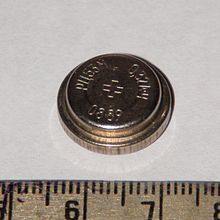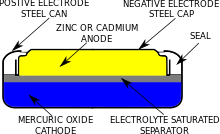Mercury Oxide-Zinc Battery
The mercury-zinc battery has an anode made of zinc powder and a cathode made of mercury oxide . The electrolytes form a jelly-like mass of zinc hydroxide . A mercury oxide-zinc battery delivers an extremely constant voltage of 1.35 volts . Towards the end of the battery's life cycle, the voltage drops very rapidly. For this reason, this type of cell was often used by the photo industry for the operation of exposure meters , since a reference voltage that is as constant as possible is necessary for this . The button cell type with the designation PX625 was used for this purpose.
When operating the battery, the following reactions take place:
The redox reaction can be briefly described as follows:
The overall reaction looks like this:
Button-cell mercury oxide-zinc batteries were previously used a lot in small devices with low power requirements (e.g. wristwatches) or as hearing aid batteries . However, if these button cells are not properly disposed of, they represent a major problem for the environment. When they are used up, they contain mercury . If the cell is damaged, the mercury will leak and contaminate the environment. In watches, they have been replaced by silver oxide-zinc batteries . In hearing aids, on the other hand, through zinc-air batteries , which have a higher energy density but also a higher self-discharge.
As of 1992, EU Directive 91/157 / EEC banned batteries in the EU that contained more than 25 mg of mercury, as well as alkaline-manganese batteries with more than 0.025% of the filling being mercury. In 1999, the ban was extended so that all batteries may contain a maximum of 0.0005% of their fill weight in mercury. In Germany this is regulated by the battery ordinance . A similar ban was passed in the USA in 1996 with the Mercury-Containing and Rechargeable Battery Management Act . In the meantime, the manufacture and trade of and with mercury oxide-zinc batteries have ceased worldwide.
Individual evidence
- ↑ Council Directive 91/157 / EEC of March 18, 1991 on batteries and accumulators containing dangerous substances
- ↑ Public Law 104-142, 104th Congress






